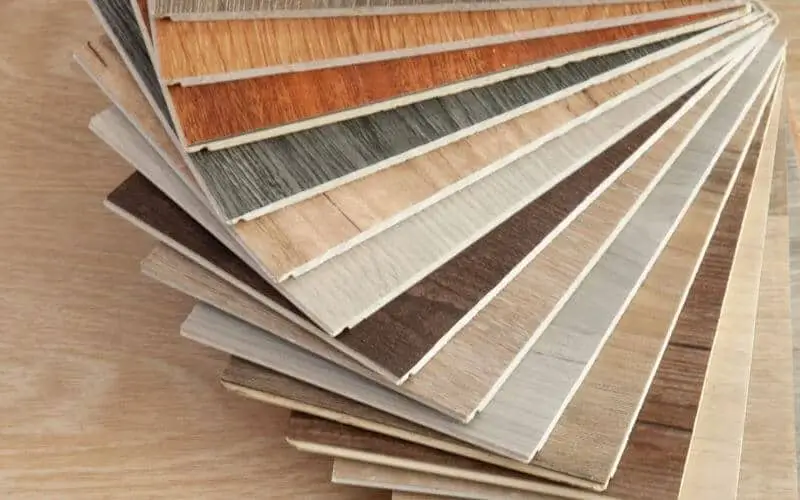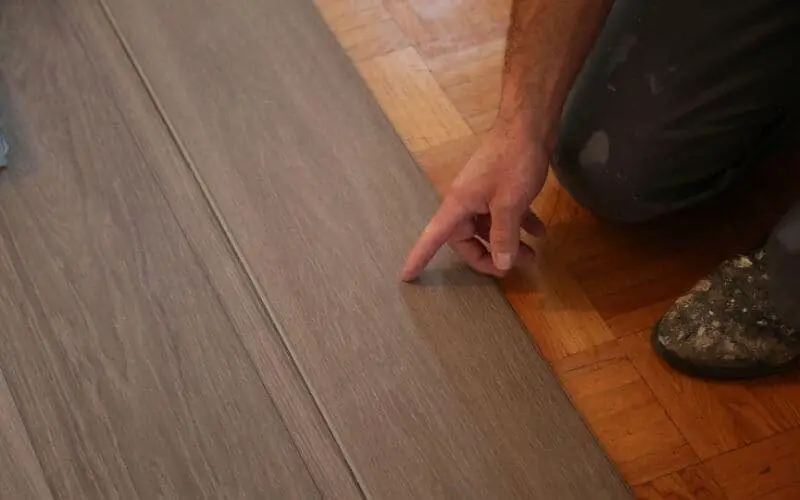In today’s homes, both laminate and vinyl flooring are popular options. They are inexpensive, appealing, and simple to maintain. But what’s the difference between them?
Admittedly, there are certain similarities between the two flooring options. However, we are more concerned with how to tell the difference between vinyl and laminate flooring.
For starters, when it comes to sizes, the vinyl floor comes in single-layered sheets ranging from 1/8 to 3/16 inch thick, while the laminate floor is quite thick given that it is made up of four layers and is 3/8 inches thick.
Read on as we explore more differences between laminate and vinyl flooring.
What Is Vinyl Flooring?
Vinyl flooring is made up of several layers that work together to create a long-lasting, waterproof surface. It has a solid vinyl core with a printed vinyl layer.
These synthetic materials improve your floor’s moisture resistance by allowing water to sit for extended periods of time without causing damage.
Vinyl flooring comes in a variety of styles, including engineered vinyl planks, WPC vinyl, and Rigid Core vinyl flooring.
Vinyl flooring used to be limited in terms of design options, but vinyl has been upgraded to a wider range of styles and patterns for a more modern and appealing appearance.
What Is Laminate Flooring?
Laminate flooring was one of the first manufactured replacements to hardwood floors, having been introduced in the 1970s.
It’s an excellent option for homeowners who desire the look of hardwood floors but don’t want to spend a lot of money on flooring.
Its thick structure makes it rather comfortable to walk on, making it suitable for living rooms and corridors.
Laminate, like vinyl, is comprised of synthetic materials that mimic the look of genuine hardwood. Laminate layers are comparable to vinyl flooring, but they are built of different materials.
Unfortunately, laminate flooring does not withstand dampness as well as vinyl flooring. While certain laminate flooring options are water-resistant, they can still be harmed if exposed to water for an extended length of time.
How to Tell the Difference Between Vinyl and Laminate Flooring?
Table of Contents
- 1 How to Tell the Difference Between Vinyl and Laminate Flooring?
- 1.1 1. Laminate Flooring Contains Little Amount of Woods
- 1.2 2. Vinyl Floorings are Water Resistant
- 1.3 3. Vinyl Floors can Emit Hazardous Substances
- 1.4 4. Laminate Flooring is Environmentally Sustainable
- 1.5 5. Vinyl Floors are Fire Resistant
- 1.6 6. Laminate Floors are Easier to Install
- 1.7 7. Vinyl Floors are Easier to Maintain
- 2 Can You Tell the Difference Between Vinyl and Wood Flooring?
- 3 Conclusion
1. Laminate Flooring Contains Little Amount of Woods
Vinyl flooring is essentially made of plastic. The planks are formed of a thicker version that has been printed with a design, usually resembling wood. One or two layers of polyurethane are applied on top to protect the design from wear and tear.
Laminate flooring, on the other hand, contains a small amount of wood. The core is formed from wood byproducts – sawdust – that are glued together with resin.
This is then printed with a design that makes it appear to be real wood. In addition, similar to vinyl flooring, a plastic coating is applied on top to prevent the design from fading away.
2. Vinyl Floorings are Water Resistant
Water will not be able to enter through the vinyl sheet flooring. The material is not only resistant to water, but it also frequently covers the entire floor in a single piece. That implies there will be no holes for water to enter.
The gaps between vinyl planks, on the other hand, will be noticeable. Those gaps should be fairly small as long as they’re correctly fitted. However, if the water remains on the surface for an extended period of time, it can soak through.
The good news is that it will cause relatively little damage when it does occur. The planks will not disintegrate because they are made of vinyl. As a result, even if any moisture gets underneath your floor, it will remain firm.
As a result, vinyl is an excellent choice for wet or humid locations such as bathrooms, kitchens, and utility rooms.
Laminate, on the other hand, is more prone to moisture damage. As with vinyl planks, there will be small spaces between the flooring strips that might allow water to enter. And because the product’s core is made of wood, this can result in damage.
As a result, it’s recommended to limit the use of laminate to places that won’t be subjected to a lot of dampness. If you use it in living rooms, dining rooms, or bedrooms, you should have no problems in most weather.
Don’t give up if you want laminate yet live in a high-humidity environment. Look for laminate flooring that has been subjected to a high level of pressure.
3. Vinyl Floors can Emit Hazardous Substances
When it comes to using vinyl flooring in your home, there is one major disadvantage: it can emit hazardous substances.
Vinyl contains a variety of compounds, some of which are hazardous to one’s health. Manufacturers have attempted to address concerns by certifying certain types of vinyl flooring as low in VOCs (volatile organic compounds).
However, while low-VOC choices are preferable, some chemicals remain. These can be released into your home’s air.
Laminate flooring, on the other hand, does not contain any of these chemicals. And the chemicals it does contain are mostly contained within the flooring’s core. That is, it will not have the same impact on the air quality in your home.
4. Laminate Flooring is Environmentally Sustainable
When it comes to environmental sustainability, laminate flooring outperforms vinyl.
Vinyl is made from petroleum, which is a nonrenewable resource. Toxic substances are produced throughout the manufacturing process.
Furthermore, there are extremely few recycling facilities. The great majority of discarded vinyl flooring will end up in a landfill. And once there, the toxins will continue to leak into the earth.
Read: Pros and cons of laminate flooring
5. Vinyl Floors are Fire Resistant
As mentioned above, vinyl floors are water-resistant. It follows that once ignited, its impermeability to water makes it difficult to extinguish.
Laminate flooring is made of moderately combustible material. The chemicals phenol and formaldehyde are utilized to bind the several layers together. They emit hazardous gases such as carbon monoxide and nitrous oxide as they burn.
6. Laminate Floors are Easier to Install
Depending on the type of flooring you choose, laminate and vinyl flooring installation might be rather simple. They can all be good choices for folks who prefer do-it-yourself projects.
Laminate flooring is installed with a click-and-lock system. This means that the planks are fitted into the grooves of adjacent planks, and when they’re secured in, the seam is closed.
The majority of laminate flooring projects are done as “floating” floors, which means they can be laid over your existing flooring. You can trim down parts to fit your floor with an ordinary table saw.
Vinyl provides more options for installation procedures. You can also choose between click-and-lock planks, peel-and-stick, glue down, and other options.
Sheet vinyl is harder to work with because it is heavier and requires precise cutting around the shapes and angles in your room. As a result, expert installation may be required.
Read: How hard is it to install vinyl plank floorinh
7. Vinyl Floors are Easier to Maintain
This also stems from that vinyl floors are water-resistant. It’s fine to mop these floors with a damp mop since they are resistant to water.
For stubborn stains, scrub them using approved cleaning agents. Vinyl can be cleaned using a variety of methods, and it does not require much maintenance other than cleaning.
On the other hand, maintaining laminate floors can be a tad difficult because it is not water-resistant.
Caring for and cleaning laminate flooring can be a more delicate operation. It’s better to utilize dry cleaning methods, such as a broom or a dry mop. Use a damp mop that is almost dry when touched if you need to mop.
Can You Tell the Difference Between Vinyl and Wood Flooring?
Even with the differences highlighted above, it is still a bit difficult to tell these two flooring options apart. Well, below is a tabular guide that should be of help.
| Vinyl Flooring | Laminate Flooring |
| Vinyl floors come in layered sheets measuring 1/8 up to 3/16 inches thick. | Laminate floors are made up of four layers and are 3/8 inches thick. |
| Vinyl floors are water-resistant | Laminate floors are not water-resistant |
| Vinyl floors are glued to the surface of the floor. | Laminates are installed by placing them together until they snap together |
| Vinyl floors are not so easy to install | Laminate Floors are easier to install |
| Vinyl floors are way more expensive than laminate floors | Most laminate flooring can be purchased for about $1-5 per square foot. |
Conclusion
Both laminate flooring and vinyl flooring are excellent choices for anyone looking for a do-it-yourself project and economical, long-lasting floors.
However, in this post on how to tell the difference between vinyl and laminate flooring, we realized that vinyl floors are resistant to moisture and spills, while laminate floors provide a more authentic wood look to improve your home’s design.

